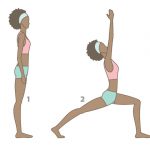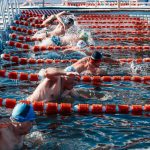How much do you need to train in your wetsuit?
Earlier this summer, southern England was blessed with unusually warm weather and a number of our gravel pit lakes hit 25 degrees Celsius, which isn’t far short of what you find in a heated indoor pool. Wearing wetsuits in water this temperature is (in my opinion) quite uncomfortable, especially when the sun is beating down. It’s possibly even dangerous. So why do so many people continue wearing their wetsuits when the water is so warm?
When quizzed, people tend to say they will be wearing a wetsuit when they race (either because it’s compulsory or because the water will be cooler) so they need to practise swimming in it. There is some sense in this. It’s obviously important to be familiar with your race kit but I’m not convinced that doing all your outdoor swimming encased in neoprene is the best way to prepare for a wetsuit race. I also think you miss out on one of the biggest joys of open water swimming: the feeling of cool water against your skin.
Most of this summer I’ve only worn a wetsuit when it’s been compulsory for a race or if I’m testing one for a review. Last week I chose to wear one for a race where it was optional, which I partly did as an experiment and partly because I wanted my name to appear higher up the rankings. It was the first time I’ve worn this particular wetsuit since the Great Manchester Swim and only the second time I’d ever worn it. I haven’t done any training or practice in it. Even so, I swam 5:40 quicker over 3km that I did over the same course two months previously without the wetsuit. This is equivalent to a little over 11s per 100m faster.
Earlier this summer I took part in Henley Swim’s Suits vs Skins challenge where I swam a mile twice: once with and once without a wetsuit. For both of those swims I found myself swimming alone and so didn’t receive any benefit from drafting. The wetsuit improved my pace by 7s per 100m. The other 4s per 100m came from two sources, I believe. Firstly, it was a different, newer and higher-end suit and, secondly, I made a determined effort to draft.
But the point is, these gains were available even without doing any specific training in a wetsuit. In fact, I think there are training benefits to doing a good part of your open water training without a wetsuit. Primarily, you have to keep focused on holding good swimming technique, especially the position of your legs, in order to maintain speed without a wetsuit. You also have a much better awareness of what your body is doing and where it is in the water when you don’t wear a wetsuit.
A wetsuit helps you swim faster in part by compensating for technique flaws, so if you swim in one a lot it gives you less opportunity to fix those flaws. To swim faster in a wetsuit then, try doing more open water swimming without one. You will become a better and more confident open water swimmer and when you do put a wetsuit back on for your race, you’ll really notice and appreciate the difference.






